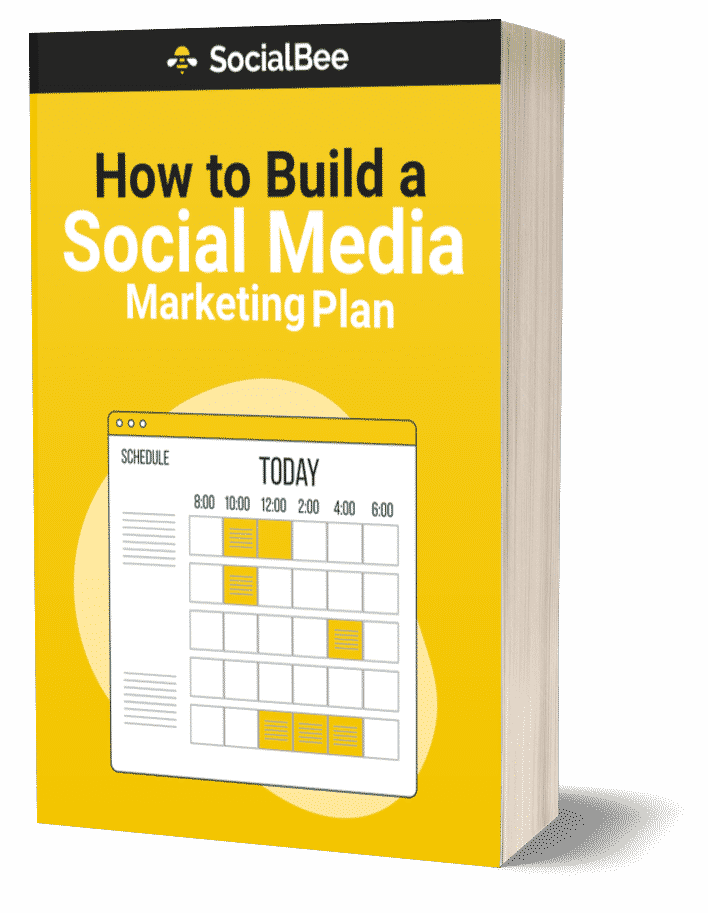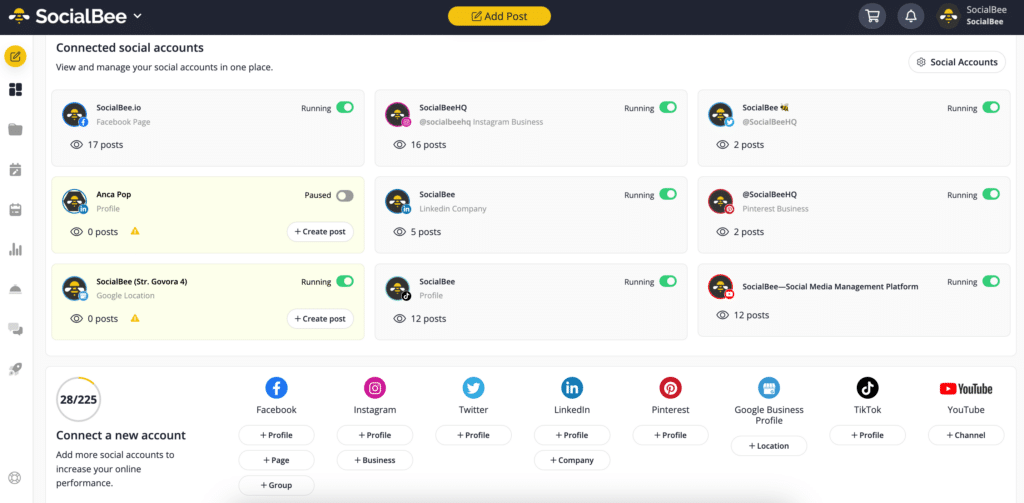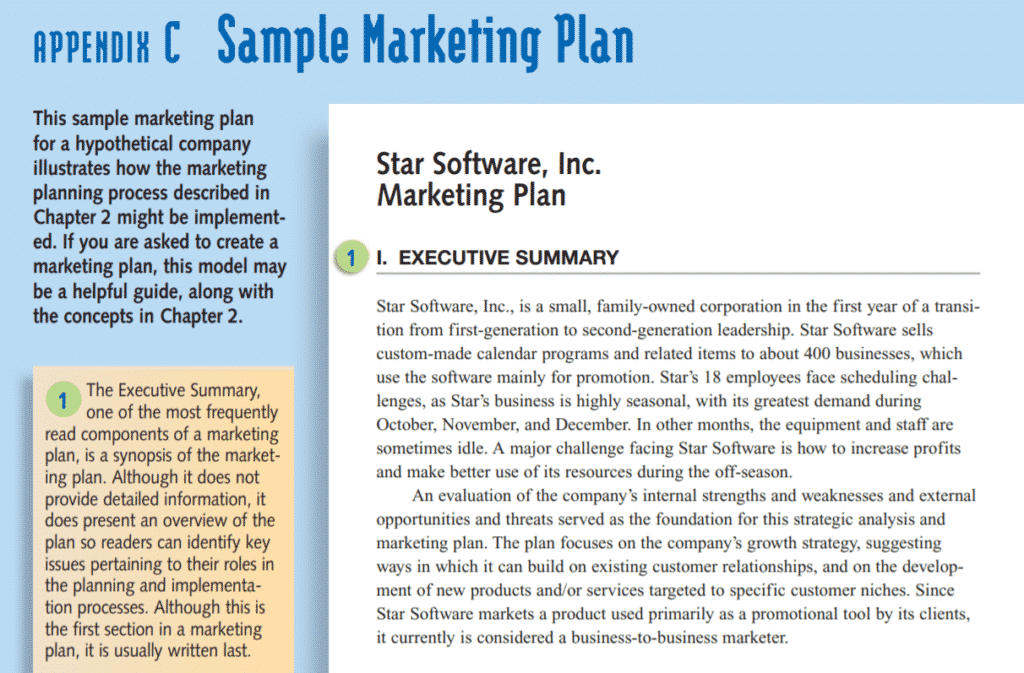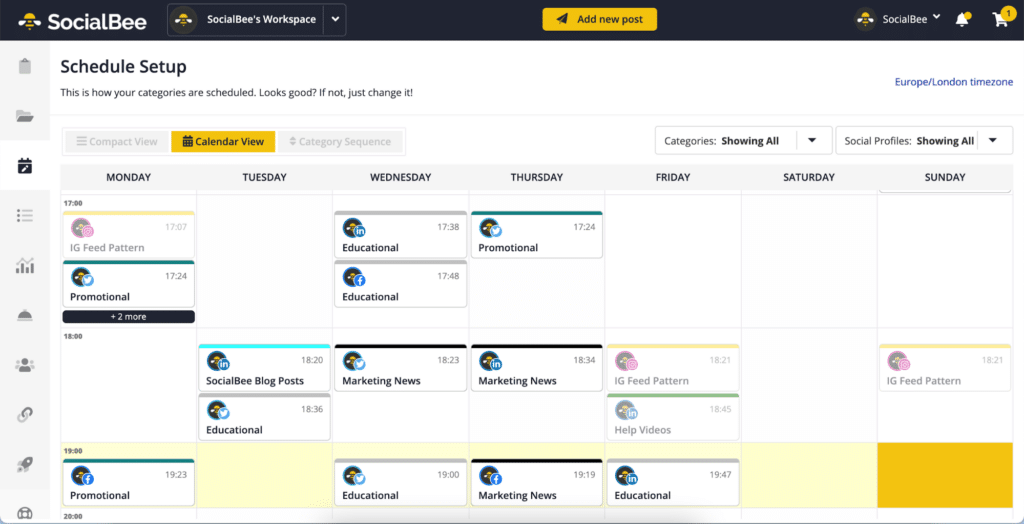
Content Manager at SocialBee
No matter what you’re looking to improve – whether it’s building a stronger social media marketing plan, growing your market share, realigning your marketing with your business strategy — your growth is guaranteed by the following marketing plan example.
Through our digital marketing plan template, you will learn about the structure of a marketing plan, how to build one, the best tools you should use in the process, and everything in between. So, let’s get started!
Get the guide for creating a social media marketing plan for your business.

What Is a Marketing Plan?
Marketing plan definition: A marketing plan is a document that keeps track of all the marketing activities a business plans over a specific time frame. It’s a comprehensive plan that helps you evaluate the progress you made so far through your marketing strategy while helping you develop, monitor, and improve your strategy in an organized and effective manner.
A good marketing plan contains information about:
- The current marketing situation of a business
- The future marketing strategy, activities, and objectives
- Deadlines for all future tasks
- Marketing KPIs
Types of Marketing Plans
A marketing plan can take several forms, seven to be specific:
- Business launch marketing plan
- Quarterly or annual marketing plan
- Content marketing plan
- Email marketing plan
- Paid marketing plan
- Retention marketing plan
- Social media marketing plan
1. Business Launch Marketing Plan
Do you plan to launch a new business, or maybe a new product? Then you must prepare for success.
A business launch marketing plan will help you organize your market research, goals, activities, and overall marketing strategy in one document.
The main objective of such a plan is to stay focused on key information and actions that have the potential to boost the results of your marketing efforts.
2. Quarterly or Annual Marketing Plans
This type of marketing plan breaks your strategy into specific time frames. As a result, you can pay close attention to each marketing initiative, rather than focusing only on the big picture.
Besides, by dividing your marketing strategy into shorter periods of time, you will be able to switch up your strategy and find out what marketing approaches work best for your business.
3. Content Marketing Plan
A content marketing plan is used to optimize the content strategy of a company with the goal of attracting, engaging, and retaining as many customers as possible.
To create such a successful marketing plan, you must write down your mission and goals, identify the most valuable communication channels and create a content plan that will help you maintain a consistent messaging strategy, build brand awareness and generate sales.
| Lucky for you, we have a comprehensive content marketing plan template here that you can download and customize for your own business. |
4. Email Marketing Plan
To create an email marketing plan, you need to write what they want to achieve through your future email campaigns and also establish how you plan to achieve your marketing goals and measure your progress.
Furthermore, in an email marketing plan, you should also include information about the email marketing software cost you plan to use, the content and schedule of your emails.
5. Paid Marketing Plan
This plan only refers to the paid marketing practices you want to use in order to promote your business and boost your sales (such as Google and social media ads, commercials, etc).
It includes information about the objectives and content of your ads. as well as information about your target customers (demographics, interests, challenges, buying behaviors).
Most importantly, a paid marketing plan can help you stay on budget and make the most out of your resources.
6. Retention Marketing Plan
A retention marketing plan compiles all the marketing activities dedicated to improving customer loyalty.
It contains information about:
- The customer base
- Customer feedback
- Company challenges that contribute to churn rates
- Future practices meant to improve customer retention
- Marketing goals
- Progress monitoring tactics and tools
The main goal of a retention marketing plan is to create a stable source of income for your business by keeping your customers happy and willing to purchase from your brand regularly.
7. Social Media Marketing Plan
This plan concentrates solely on the social media aspect of your marketing strategy.
It includes information about your:
- Social media objectives
- Target audience
- Competitors
- Social media content and ad strategy
- KPIs
A social media plan is essential if you want to expand your audience, generate new leads, boost your sales and develop a loyal customer base.
Marketing Strategy vs. Marketing Plan
Is a marketing strategy the same thing as a marketing plan?
Although we often see the two terms used interchangeably, there are some fundamental differences between the two.
A marketing strategy defines what your business needs to achieve in a certain time frame and the reason behind it. On the other hand, a marketing plan identifies the way to achieve your business goals while focusing on the practical steps of the process.
To better differentiate the two concepts, you can associate each practice with the following sets of questions:
- Marketing strategy – What? Why?
- Marketing plan – How? When? Where?
What Are the 7 Elements of a Marketing Plan?
To make the most out of your marketing plan, you first have to define the seven P’s of marketing:
- Product
- Price
- Promotion
- Place
- People
- Process
- Physical evidence
These elements combined are also known as the marketing mix — the practice used to place a business on the market and figure out a pricing and positioning strategy.
1. Product: Define the Product You Are Marketing
Perform a target audience research and answer the following questions:
- What characteristics make your product unique?
- How does it benefit your audience?
- Why should your audience invest in your product? What customer pain points/needs does it solve?
2. Price: Settle on a Price
Evaluate the average prices on the market and answer the next set of questions:
- Does the price of your product reflect the quality of your product?
- How do you justify your pricing?
- Does the price of your product match the financial possibilities of your target audience?
- What are the pricing differences between you and your competitors?
3. Promotion: Develop a Promotional Strategy
Answer the questions below to identify the best promotional tactics for your business:
- What offline and online channels should you use to promote your product?
- What organic marketing strategies do you plan to use for promotional purposes?
- How will you advertise your product?
4. Places: Find the Best Locations to Sell Your Products
Follow the journey of your products, from manufacturing to selling, and identify what locations you need to run your business.
Answer the following questions:
- Where do you manufacture your products?
- Where can your customers find your products?
5. People: Identify the Human Resources You Need to Run Your Business
Think about the structure of your business and answer the questions below:
- Who are the people/departments that make your business possible?
- What are the main traits and skills your ideal employee should possess?
- How do you want your customers to perceive your staff?
6. Process: Outline the Mechanism Behind Your Products
Mention all the procedures and activities that influence how your product is created, promoted, and sold to your customers.
Make sure to answer the next questions:
- What are the processes involved in delivering a product to your audience?
- What does the buyer’s journey look like (from discovery to purchase)?
7. Physical Evidence: Name the Physical Elements Surrounding Your Product
For this step, you need to consider all the tangible elements your customer encounters while interacting with your business.
Start by answering the following questions:
- How would you describe the physical locations where your customers interact with your products (ambiance, decor, equipment, noise, light temperature, advertisements, etc.)
- What do your customers receive when purchasing your product (branded bags, catalogs, flyers, etc.)?
Now, with all the elements of a complete marketing plan defined, it’s time to learn about how you can write a detailed marketing plan specific to your business.
Keep reading to find out more about the topic!
How to Build Your Marketing Plan
- Make Sure You Have A Strong Brand
- Set Your Marketing Objectives
- Establish Your Marketing Budget
- Describe Your Target Market
- Identify Your Competition
- Choose Your Main Marketing Channels
- Outline Your Marketing Strategies
- Track and Measure Success
To make it easier for you to create a marketing plan, we divided the process into eight simple steps.
So, make sure to follow this marketing plan example as much as you can while creating your own outline.
1. Make Sure You Have A Strong Brand
When you create your own marketing plan, you have to start by defining your brand.
Why? Because you must align all your marketing activities to your brand’s identity. This will allow you to make the most out of your marketing strategy and maintain a consistent presence across all marketing channels.
In addition, a strong brand will help you differentiate yourself from the competition and become a memorable presence on the market. So, let’s take a look at how you can emphasize your brand through your marketing plan.
A. Define Your Unique Selling Proposition
Your unique selling proposition is a statement that answers the following question: Why should your potential clients purchase from your business and not from your competitors?
A USP can be anything from the lowest prices on the market to customizable packaging or a fast delivery system. Moreover, it must solve a challenge or offer benefits that significantly improve the customer experience.
Through a USP, businesses make a promise to their customers. However, this promise will not hold up if it’s not respected.
The key to developing a strong USP is to write a short and memorable statement. Apart from this, it must be customer-focused, meaning that it must outline the main benefit a business has to offer to its customers.
Here are some USP examples you can use for inspiration:
- FedEx: “When it absolutely, positively has to be there overnight.”
- Siteground: “Expert Hosting Support Our Customers Love.”
- Postmates: “Anything, anytime, anywhere.”
- Saddleback: “They’ll Fight Over it When You’re Dead.”
- L.L.Bean: “Free shipping to US and Canada every day. No minimum order, no end date.”
B. Determine Your Mission Statement
A mission statement can provide meaning and purpose to your business. It goes beyond what products and services you provide by communicating the reason your business exists.
Similar to your USP, your mission acts as a differentiating factor that makes you stand out from your competition. In addition to this, it gives your potential customers an extra reason to purchase from you.
Therefore, in order to write an effective mission statement, you must research your audience and find out their values. After all, your mission must reflect their own beliefs and morals, otherwise, it won’t be strong enough to resonate with them.
Also, make sure to keep your statement short, memorable, and to the point.
To understand the ideal structure of a mission statement, check out the following examples below:
- LinkedIn: “The mission of LinkedIn is simple: connect the world’s professionals to make them more productive and successful.”
- PayPal: “To build the web’s most convenient, secure, cost-effective payment solution.”
- Patagonia: “Build the best product, cause no unnecessary harm, use business to inspire and implement solutions to the environmental crisis.”
- Sweetgreen: “To inspire healthier communities by connecting people to real food.”
- Warby Parker: “To offer designer eyewear at a revolutionary price, while leading the way for socially conscious businesses.”
2. Set Your Marketing Objectives
Now that you have a good understanding of your USP and business mission, it’s time to define your future plans by developing a list of strategic marketing objectives.
This step is essential as it influences your marketing decisions and provides clear directions for your marketing team. In addition, crafting your plan with a set of current marketing objectives in mind will help you and your team to stay focused on key practices that will improve your marketing efforts month after month.
The structure of your marketing objectives is one of the main elements you should pay attention to. You must avoid being too vague while trying to keep your objectives short and clear.
In order to make sure you write the best business objectives, you can follow the S.M.A.R.T. formula:
- Specific – Mention exactly what you want to achieve and how you plan to do it.
- Measurable – Define the way you will measure your success.
- Attainable – Stay realistic and set objectives that you can accomplish in a certain time frame.
- Relevant – Align your objectives with your business needs.
- Timebound – Set a deadline for all your objectives.
Here is an example of a S.M.A.R.T marketing objective:
| “Increase sales by 15% in the next three months by gaining more website traffic with the help of weekly email newsletters.” |
It should be noted that you should strive to achieve three to five objectives per quarter. After all, you don’t want to pressure and overwhelm your marketing team.
Wanting to achieve too many things at once is a recipe for disaster. Whereas, focusing only on a few of them will ensure that you have the time to elaborate a successful marketing strategy around your objectives.
Do a SWOT Analysis
SWOT stands for strengths, weaknesses, opportunities, and threats. Such an analysis is a great way of evaluating your business — it’s easy and it doesn’t take a lot of time out of your schedule.
Conducting a SWOT analysis will help you discover how you can improve your business. Moreover, it will give you the right insight for writing effective marketing objectives.
Furthermore, to perform a SWOT analysis, you must answer the following questions:
3. Establish Your Marketing Budget
As with any other aspect of your business, your marketing strategy requires a budget. Although there are many organic practices you can use to promote your business, paid media can significantly contribute to your marketing success.
No matter how many financial resources you have available, you still have to allocate them responsibly if you want to get the most out of them. So, get your calculator ready, and let’s see how you can set a budget suitable for your own marketing plan.
A. Align Your Marketing Activities with Your Pricing Strategy
Your marketing budget should be aligned with your pricing strategy. After all, the way you price your products will determine how much profit you are going to make.
A part of that profit goes back into your business and your marketing budget. That is why you have to make sure that the price of your products will allow you to generate enough financial resources for you to invest in your marketing strategy — the main aspect of your business plan that will boost your sales and gain new customers.
B. Calculate Expected Costs and ROI (Return of Investment)
Before you invest in certain marketing tools and practices, you have to evaluate how profitable they will be for your business. This includes calculating both the costs and the returns of your investments.
Basically, to determine if an investment is worth pursuing you have to answer the following questions:
- How much will it cost?
- How much revenue will it produce?
- What are the main risks?
- What are the benefits of investing in it?
Based on your answer, you have to make a decision that will increase your profits and prevent you from losing resources.
To calculate your ROI you have to:
- Deduct the initial cost of the investment from its final value
- Divide the result by the cost of the investment
- Multiply the number by 100
C. Allocate Your Marketing Budget
With your ROI calculated, it’s time to allocate your budget based on the marketing practices and tools you will include in your plan.
In this section of the plan, you have to include all your expenses, such as employee salaries, ads, software costs, and more. As a result of this, you will manage to stay on budget while investing in the marketing practices with the most value.
4. Describe Your Target Market
Is the customer always right? Debatable. But is the customer always important? Yes, 100% of the time.
Your customers should influence your entire marketing plan, meaning that everything from your branding and messaging strategy to the design of your products should reflect your target audience’s values, wants, and needs. This idea should also guide you when designing your SMS marketing strategy.
Because your customers are your source of income, you must do your best to provide them with the best customer experience possible. With this in mind, let’s look at how you can improve your marketing strategy by researching your potential customers.
A. Analyze Your Current Audience
The goal of researching your target market is to develop products and services so personalized that consumers choose to purchase from your business rather than from your competitors.
The first step of your market research is to analyze your existing customers. Pay attention to the way they communicate with your business and the feedback they provide.
Next, you can go through your social media and Google analytics to find out more about them:
- Age
- Gender
- Location
- Language
- Interests
- Browsing behavior
- Device type
Also, you can even consult with your sales team to find out more about personality traits and buying behaviors.
Make sure you also discover the online communication platforms your customers use — this will be especially important while developing your social media and content marketing strategy.
To identify the most relevant social media platforms for your business you should use the demographics from your target market research and check Statista to see if there is an audience for you on those channels.
B. Build Buyer Personas
All the data you just gathered through your audience research can be hard to keep in mind while developing your marketing strategy. However, there is a way you can package all this information in a more attractive format — buyer personas.
A buyer persona is a representation of your ideal customer, a fictional character that you build based on the information you have about your customers. You can even go as far as providing a name and a physical appearance for your buyer persona.
If you cater to a large and diverse group of people you might want to consider creating more buyer personas. However, you shouldn’t develop too many of them as it can quickly transform your corporate strategy from a personalized approach to a general one.
To develop a buyer persona you should include a detailed description of your ideal customer, containing the following details:
- Name
- Demographic information
- Interests
- Behavioral characteristics
- Challanges/pain points
- Objectives
- Values
- Buying behavior
- Needs
- Desires
| You can develop buyer personas for free right here. |
5. Identify Your Competition
If you want to stay relevant in a competitive market, you have to keep up with your competitors and beat them at their own game. And what better way to do it than by researching their marketing strategy and using that information to improve your marketing efforts.
Your competitors can actually help you develop your growth strategy. By following their online marketing activity you get to find out their strengths and weaknesses.
So, use this opportunity to include their good habits into your own marketing plan and use their weaknesses to your advantage.
A competitive analysis contains the following sections:
- Target audience research
- Product/service information
- Pricing details
- Website analysis
- Social media strategy
- Content marketing strategy
- Email marketing strategy
- Digital marketing strategy
- Sales techniques
- Business reviews
- Sentiment/public opinion
Competitor Analysis Tools
As you can imagine, going through every element of your competitors’ marketing strategy can take a lot of time and energy if done manually. But don’t worry, there are plenty of affordable tools you can use to optimize the research process.
Here are three of our recommended picks:
- Brand24 – This social media monitoring tool helps businesses discover online mentions, monitor competitors, and track the performance of their marketing campaigns. In addition, Brand24 crawls the web to discover your mentions from different review pages, newsletters, blogs, forums, and it provides you with information about: search volume, reach, engagement, sentiment, and trending topics.
- SE Ranking – SE Ranking is an all-in-one SEO tool that allows users to perform extensive website audits, competitor evaluation, keyword suggestions, backlink monitoring, and create automated professional reports.
- Similar Web – This monitoring tool is great for tracking competitors. It allows users to see both the traffic their competitors get and their traffic sources (social traffic, referring sites, etc.). Moreover, by using this tool you can also discover the keywords your competitor uses to rank higher on SERP.
6. Choose Your Main Marketing Channels
There are a lot of marketing channels that can boost your business results, however, we would like to focus on the five most important ones that any brand should consider.
Here are the most important marketing channels:
- Social media marketing
- Search engine optimization
- Blog marketing
- Email marketing
- Word-of-mouth marketing
1. Social Media Marketing
Social platforms allow businesses to grow brand awareness, increase their website traffic, boost their sales and build a loyal customer base through their content strategy.
The key to social media success is to deliver quality content customized for each platform and maintain a consistent posting schedule. And you can do just that from the SocialBee dashboard, only faster and easier than ever before.
Start your 14-day SocialBee free trial today to make the most out of your social media strategy!
Furthermore, community management is also important. Therefore, you should use your online platforms to both interact with your audience and solve customer service issues.
2. Search Engine Optimization (SEO)
SEO should be at the top of your priority list.
There is no marketing channel more important than this one. In fact, 80% of all purchases (both online and in-store) begin with online research.
People use search engines for everything, to either purchase a product online, find a physical store near them, search for a doctor’s office or research products and services they are interested in at a certain time. Google is also the marketing channel with the highest conversion rate, followed by Bing.
So, as you can imagine, developing a marketing strategy that will place your business website at the top of the results page is extremely important.
To improve your SEO you want to consider the following practices:
- Obtain links from other websites.
- Use optimized keywords relevant to your industry.
- Write quality and engaging content.
- Create unique keyword-focused titles.
- Optimize your images.
- Add internal and authoritative external links to your content.
- Go for short and keyword-driven URLs.
- Improve the loading speed of your website.
- Develop an appealing and user-friendly website design.
3. Blog Marketing
Creating a blog will offer many growth opportunities for your business.
For example, you will be able to include link building and content marketing into your growth strategy. As a result, you will gain more website traffic, build authority in your industry, and improve your SEO.
Tips to build a successful content marketing strategy for your blog:
- Identify topics that are highly interesting for them and write articles that provide answers to their questions.
- Add internal links to your articles, tie them to relevant keywords that match the search intent of your potential customers, and redirect them to your most valuable pages (other articles, products, and contact pages).
- Make sure to include CTAs that will encourage your readers to act: buy your products, subscribe to your newsletter, follow you on social media, etc.
4. Email Marketing
Email marketing is still one of the most effective marketing channels that can help you generate and nurture leads, gain website traffic and keep your customers updated regarding company news, promotions, and newly posted blog articles.
To make the most out of this marketing practice you have to:
- Invest in quality software.
- Expand your email list.
- Write powerful subject lines.
- Write engaging emails.
- Create campaigns for individual marketing goals.
- Maintain a consistent messaging schedule.
- Track your results.
- Adjust your strategy.
5. Word-of-Mouth Marketing
Did you know that 92% of people trust recommendations from friends and family more than they trust any other forms of advertising? Yes, you heard that right.
Word-of-mouth marketing is extremely effective because the people who promote your business are objective and trusted sources of information that don’t have anything to earn from advertising your business.
Word-of-mouth is the most honest marketing channel because it exists due to the quality of your products and services.
Of course, there are other methods you can generate word-of-mouth hype around your brand such as:
- Collaborating with influencers.
- Providing excellent customer service.
- Sharing reviews, testimonials, and user-generated content.
- Developing a brand ambassador program.
- Creating an affiliate marketing program.
7. Outline Your Marketing Tactics
Now that you know what marketing channels you should use for your business, let’s see the main tactics that can help you boost their performance.
A. Customer Testimonials
A great way to gain the trust of your audience is to use your customers’ testimonials as a promotion tactic.
All you have to do is get in touch with your most important clients and ask them to write a short description of their experience with your business.
Include those testimonials on your website, add them to your content strategy and share them on all your socials.
B. Case Studies
Case studies are reports that a business shares with its audience to prove how its products and services can solve their problems and fulfill their needs.
These reports are normally created around one customer success story. It describes the entire customer journey by providing details about the customer issue, the process of solving the problem, and the end results.
It’s an effective marketing tactic because it focuses on real-life examples to promote certain products and services.
C. Influencer Collaborations
If you want to boost the visibility of your brand and increase your sales in a short time frame, influencer marketing is for you.
By collaborating with a popular influencer from your niche, you get to:
- Expose your brand to a large audience.
- Use the credibility of an online figure to gain trust.
- Gain brand awareness.
- Grow your online platforms.
- Boost your sales.
D. Affiliate Programs
Affiliate marketing is another popular advertising model businesses use to promote their brand. It works by paying other bloggers to advertise your products on their website through link insertions, product reviews, and blog posts.
Affiliate programs are marketing budget-friendly practices that help you generate more traffic, increase sales and brand visibility, and also build authority within your niche. And to top it all off, they have a great return on investment.
8. Track and Measure Success
Marketing is a constantly evolving branch of your business strategy, meaning that what worked two years ago might not work now. For this reason, you have to:
- Keep an eye on new trends and innovations
- Monitor and track your results
- Adjust your strategy
So, let’s have a look at how you can ensure your marketing strategy stays fresh and more effective than ever with the help of marketing metrics and KPIs.
A. Marketing Metrics
Marketing metrics are quantifiable values professionals use to track and measure the progress they make over time. Moreover, metrics may differ depending on the channel or the marketing campaign you are running.
So, to make sure you are on the right track with both your strategy and your marketing campaigns, make a list of all the success metrics relevant to your company and check on them regularly.
B. Key Performance Indicators (KPIs)
While marketing metrics measure the progress of a specific business process, KPIs track how close you are to achieving a certain marketing goal. And a great way to measure how close you are to achieving your marketing goals is to set between two and four KPIs for each one of them.
Also, KPIs are especially important in measuring the success of your paid social media promotions.
For instance, let’s say you have the following objective:
Boost website traffic by 20% in the next six months through link building, weekly newsletters, and social media posts.”
In this example, your KPIs should be total visits, number of new visitors, and of returning visitors.
Also, here are some general marketing metrics and KPI examples that you should monitor:
- Marketing spend per customer
- Return on marketing investment
- Lifetime value of a customer (LTV)
- Customer acquisition cost (CAC)
- Customer retention
- Marketing Qualified Leads (MQL)
- Sales Qualified Leads (SQL)
- Funnel Conversion Rates
- Brand awareness
- Customer engagement
The Executive Summary of a Marketing Plan
An executive summary is an overview of your marketing plan. It highlights the main elements of your plan while briefly mentioning the purpose and the most relevant takeaways (statistics, results, recommendations) of the document.
Here is an executive summary example you can follow:
3 Tools to Put Your Marketing Plan Into Action
Do you want to invest in marketing tools that will make a significant impact on your marketing campaigns, but you don’t know where to start?
No worries, our marketing plan example contains three tools that will give you a great advantage over your competitors.
Keep reading to find out our suggestions.
1. Social Media Posting – SocialBee
SocialBee is an all-in-one social media management tool that enables posting across multiple platforms such as Facebook, LinkedIn, Twitter, Instagram, Pinterest, TikTok, Google Business Profile, YouTube, and Bluesky.
Even if your content is assigned to multiple, different platforms, you can still customize the posts to meet each network’s requirements.
Moreover, SocialBee allows you to:
- Add your visuals directly from Canva by using our integration.
- Customize your URLs.
- Optimize your team workflow (add comments, approve, dismiss content).
- Organize your posts with content categories.
- Reshare your evergreen content.
- Keep track of your social media analytics.
The best part about SocialBee is that you can set a posting schedule for all your profiles and your content will automatically get shared across your desired social channels.
With SocialBee users can create their own social media schedule and view it in a calendar format.
So what are you waiting for? Plan your social media marketing campaigns with Neal Schaffer‘s—Forbes Top 50 Social Media Power Influencer—favorite social media marketing tool.
Start a 14-day free trial with SocialBee to see your content marketing strategies
take shape.

SocialBee: Your AI-powered social media management tool
2. Search Engine Optimization – Ahrefs
Do you want to improve your SEO game? No problem, we have a great suggestion for you.
Ahrefs is more than an SEO tool — it’s a SEO toolset that has everything you need to improve your SEO.
Let’s have a look at the best SEO tools Ahref has to offer:
- Site Explorer – This feature allows you to discover who links to your competitors, the keywords they use to rank on SERP, and also you can find out if they run any paid ads.
- Content Explorer – With this feature, you can discover the most popular content topics from your industry — this information will help you improve your content strategy.
- Keywords Explorer – This keyword tool will find the best keywords from your niche that you can use to rank higher on SERP.
- Site Audit – This tool will help you monitor and analyze your website SEO progress and identify any issues that may occur.
Moreover, Ahrefs will notify you whenever you gain or lose backlinks, keywords rankings, and web mentions.
3. Analytics – BuzzSumo
When it comes to analytics, BuzzSumo has exactly what any business needs. It offers information about both web and social media platforms.
This tool has features that allow users to do keyword and competitor research, identify influencers from their industry, and track their content marketing performance.
Get Your Sample Marketing Plan
This has been quite a long read, but at least we covered everything marketing plan-related. It’s time to stop searching for the perfect marketing plan template and build your own customized structure.
Make sure to follow the tips mentioned above to structure your marketing strategy in an effective and organized way — rest assured that you have all the details you need right here.
Also, if you are looking to step up your marketing, even more, start your 14-day SocialBee free trial and make posting social media content easier and more effective than ever before.
Get the guide for creating a social media marketing plan for your business.











 Customizable tone of voice
Customizable tone of voice  Several variations to choose from
Several variations to choose from  1,000 pre-made AI prompts
1,000 pre-made AI prompts